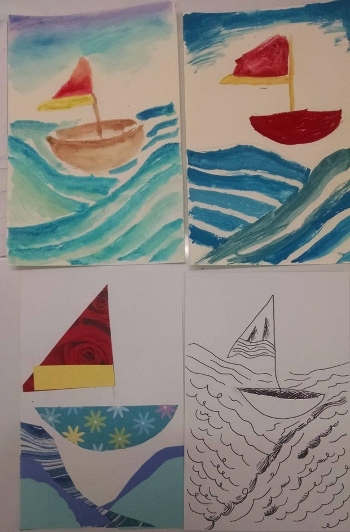We would love to hear about the mock Caldecott units you, our readers, are doing this year with your students, library patrons, etc. This year we welcome Maeve Visser Knoth, school librarian at Phillips Brooks School in Menlo Park, California, who shares what her mock Caldecott units look like.
We know that many of you — teachers, school librarians, public librarians, and even booksellers — do mock Caldecotts with students, library patrons, etc. And you know we love to hear about them! Here's our annual request for you to share in the comments what you're doing this year and maybe even which books your students / patrons are excited about. We also welcome Maeve Visser Knoth, school librarian at Phillips Brooks School in Menlo Park, California, who shares what her mock Caldecott units look like. — J.D. and M.V.P.
MAEVE: For me, mock Caldecott officially starts with the third graders estimating what 1,500 picture books look like. In my library, this is a pretty simple math project, because the entire wall of picture books underneath the windows holds approximately 1,500 books. Done. Now imagine that you are one of the judges for the Caldecott Award and picture yourself poring over some 1,500 illustrated books to discover that “most distinguished American” picture book. I then tell the students about my own experience as a judge. They love hearing about the secrecy, including the fact that my brother, who came to conferences as my nanny, would knock on our hotel meeting-room door when my then-new baby needed to be fed. Did he knock a special code? they ask.
The third graders have held a mock Caldecott unit of study since before I began at Phillips Brooks School nine years ago. The classroom teachers use it as a way to begin teaching persuasive writing, and the students often recall it as one of the highlights of third grade. I spend part of our library class time during the fall building up vocabulary, leading discussions about artistic choices, and reiterating that one artistic medium is not inherently better than another — but that one might be a better choice to tell a particular story. For instance, how does the loose watercolor set the tone for Elisha Cooper’s Homer? What is the impact of the brown-paper background in Julián Is a Mermaid? Of course, third grade is not the first time they have heard me ask them to talk about illustration, but I am a bit more intentional. By late fall I have sent piles of previous years’ winners to the classrooms so that students are spending their free reading time surrounded by Caldecott gold and silver.
For a few years, our schedule allowed for time to experiment with different artistic media, and students created the same image using several techniques. This was a powerful way to help them look at illustration. Like many things, I hope we can find time for this activity in post-COVID days. I also use Molly Bang’s Picture This: How Pictures Work to teach some principles of page design and storytelling.

And then around the time of our school's winter break, I hand the teachers a stack of a dozen mock Caldecott choices and step back. In class, the teachers share each book. Together the children pore over the illustrations, talk about the criteria, and talk about the criteria again. The students bring notebooks to the rug for each reading and take detailed notes about what they notice. They spend that final week before ALA Midwinter in deep decision mode. Each student prepares and presents a persuasive speech about their favorite from the pile. Every book gets at least one strong spokesperson before the voting begins. Then, using a weighted ballot, each class chooses a winner. The students go home Friday afternoon nervous and excited to see if their favorite book shows up during the livestreamed YMA announcements.
During these January weeks, I help build excitement by asking, when a third grader passes me on the way to the water fountain or lines up for PE, “Which book did you look at today?” I ask: “Didn’t you just love [such and such book]?” I also use library time during the weeks leading up to the announcement to share a few more possible winners, improving my chances of having shared something that wins.
The livestream itself — the ALA Youth Media Awards, the big moment when the Caldecottt winner and honors are announced — is such an exciting moment. Every year I bite my nails, hoping that something I had put on the third-grade pile shows up on the podium. And the children whisper the same prayer — but without really knowing how the odds are stacked against their having seen the winner. Last year, just one boy presented for Honor Book Outside In, and he was beside himself when he heard the announcement. The students have such ownership over the books they spend so much time with, and for weeks afterward they refer to “their” winner. They are as invested in the real winner as they are in their mock selection.
I have my 2022 pile, but as I am writing this, I still have two weeks before I have to totally commit. I’ll make changes up until I hand the pile over to the classroom teachers. And then I’ll be sure to sneak in an extra. Just in case!
JULES AND MARTHA: Thank you, Maeve, for this detailed look at your school's admirably organic mock Caldecott process, and good luck finalizing your pile of possible 2022 Caldecott contenders! And readers -- if you have your own mock Caldecott methods and traditions, please share them with us in the comments.

RELATED
ALREADY A SUBSCRIBER? LOG IN
We are currently offering this content for free. Sign up now to activate your personal profile, where you can save articles for future viewing.







Add Comment :-
Comment Policy:
Comment should not be empty !!!
Molly Sloan
Hello friends at Calling Caldecott,I am pleased to announce the results of the Oregon Mock Caldecott workshop. Librarians from across the state met virtually over two separate meetings. Yesterday we balloted our way to a winner with two honor books. Winner: Wishes by Muon Thi Van and illustrated by Victo NgaiHonor: Watercress by Andrea Wang Illustrated by Jason ChinHonor:Mel Fell by Corey TaborI also run a Caldecott Club with my 3rd, 4th and 5th Graders. We vote next Tuesday. I will also post the results of that balloting. It's an exciting season!Posted : Jan 07, 2022 09:47